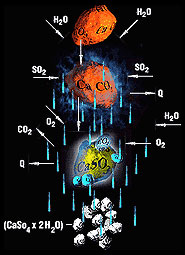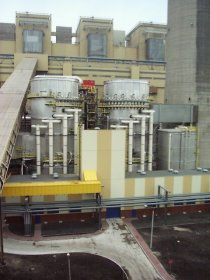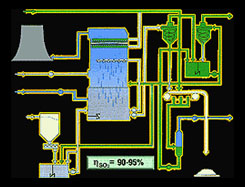OFFER
- General information
- Boiler Manufacturing Division
- Complete Power Generation Units
- Enviroment protection plants
- Oil & Gas Sector
- Metoda 200+ wg RAFAKO
- Boilers
- Waste Thermal Treatment Plants
- Services
- References
- Liquidation of stocks
Wet lime method
|
|
Wet lime method Wet lime method of flue gas desulphurisation is by far the most popular among existing, well known and highly efficient SO2 removal methods. Desulphurisation efficiency achieved with this method ranges from 90 to 95%. |
| Wet lime method consists in washing of flue gas with aqueous solution of lime or limestone. Washing process which takes place in absorption tower results in creation of calcium sulphite - CaSO3. Additional oxygenation of CaSO3 causes its conversion to CaSO4, which, in turn, after precipitation from the solution, is subject to further treatment (washing and dehydration) thus eventually producing gypsum (CaSO4 x 2H2O). After preliminary conditioning, aqueous suspension pulverised limestone or quicklime is pumped to the absorber. Special system of circulating pumps, pipelines and nozzles assures intensive washing of flue gas inside the absorption colum. Process efficiency depends mainly on the intensity of washing the flue gas with liquid (so called L/G parameter - quantity of washing medium for 1 m3 of flue gas). |
 |
During the process of flue gas desulphurisation based on wet lime method not only the sulphur dioxide is removed from flue gas. Other captured pollutants include: hydrogen chloride (HCl), hydrogen fluoride (HF) and ash. Chloride and fluoride compounds are removed along with gypsum dewatering process sewage which is then chemically treated in order to precipitate heavy metals.
Washing process reduces the flue gas temperature to c.a. 50°C thus causing the necessity to heat the flue gas once again - eg. using regenerative flue gas heater: GAVO - before directing it to the chimney.
It is also possible to direct cooled flue gas to the cooling tower thus eliminating the heating requirements. This solution enables the reduction of plant investment costs and - due to lower flue gas flow resistance - reduction of operating costs related with consumption of energy by flue gas transport system.
System for removal of flue gas from wet lime flue gas desulphurisation plant to the cooling tower is widely used in German power generation sector.
There is also a possibility of removing the flue gas via wet chimney installed on the absorber.
The problem of flue gas treatment downstream the FGD plant requires a "case by case" approach taking into account the site conditions.
Because of their high efficiency, relatively low sorbent consumption and the possibility of waste product (gypsum) utilisation, flue gas desulphurisation plants based on wet lime method are widely used in German, Japanese and American power plants. Currently, more than 90% of FGD plants operated all over the world use this technology. Polish conditions are also well adapted to this method.
JAWORZNO III FGD PLANT
In 1991 Rafako signed a consortium agreement with Steinmüller for the delivery of flue gas desulphurisation plant. In 1992, this consortium was awarded with a contract for wet lime FGD system for Jaworzno III Power Plant. In Jaworzno, flue gas from four OP-650 boilers (200 MW units) is treated. The plant includes two absorbers and each of them receives flue gas from two boilers, i.e. 2 x 1.850.000 Nm3/h.
Flue gas desulphurisation plant in Jaworzno was put into operation in 1996. It is one of the largest plants f that type in Poland. During the trial run, guaranteed SO2 emission levels were met for the whole range of loads. Currently it also demonstrates high availability. The plant is designed to treat flue gas originating from both low and high sulphur coal.Jaworzno III FGD plant contractual parameters:
Desulphurisation efficiency 95.6 %
Flue gas stream 2 x 1 850 000 Nm3/h
SO2 contents in cleaned flue gas < 200 mg/Nm3
Availability > 95 %
Process water consumption max 262 m3/h
Pulverised limestone consumption 25 t/h
Quantity of gypsum (10% moisture) max 49.5 t/h
Gypsum parameters:
Moisture < 10 %
Purity 90 %
Soluble MgO < 0.1 %
Chloride contents < 0.01 %
Sewage:
Quantity 32 m3/h
Heavy metals contents max 1 mg/l
Solid particles contents max 30 mg/l
(SO4)-2 contents 2 000 mg/l
Cl- contents 25 000 mg/l
BELCHATOW FGD PLANT
|
Belchatow Power Plant is the largest lignite fired power plant in Europe with twelve 360 MWel units and total installed capacity of 4 320 MWel. First unit was put into operation in 1982 and the last in 1988. Coal consumption amounts to c.a. 34 mln tonnes per year and annual electric power production reaches the level of 28 billions kWh, i.e. about 20% of Polish annual output. Due to its favourable location, modern technology and its large size, Belchatow produces the cheapest electricity in Poland. But money isn't the only price to pay. |
 |
Until recently, Belchatow Power Plant was one of the largest sources of SO2 emissions in the world. In 1990, power plant emitted c.a. 335.000 tonnes of SO2, whereas the total annual SO2 emission in Poland in 1990 amounted to 2 mln tonnes. Such excessively high emission levels lie behind the decision to construct flue gas desulphurisation plant in Belchatow.
The year of 1994 saw the start-up of the first wet method flue gas desulphurisation plant in Polish power generation sector. The system for four units was completed by a Dutch company. In 1995, an international call for tender was announced for the delivery of further two flue gas desulphurisation plants - for units 5 and 6 - based on the same method. The scope of the tender included: design, manufacture and delivery of necessary equipment, site erection, start-up and trial run of FGD plant together with auxiliary equipment as well as design charges for foundations and necessary modifications of existing equipment. The contract was awarded to Rafako which already acquired the license enabling it to offer and deliver flue gas desulphurisation plants based on wet lime method.
First two desulphurisation lines (units no 5 & 6) were put into operation in 2000. These are the first plants of that type constructed in Central & Eastern Europe by local companies.
|
Main technical parameters and indicators of FGD plant: Electric output 2 x 360 MWel Wet flue gas stream aver. 2 x 1700 000 Nm3/h, max 2 x 2100 000 Nm3/h Minimum availability > 97 % Limestone consumption Water consumption |
 |
Later on, the Company signed contracts with Belchatow Power Plant for turn key delivery of another FGD plants based on wet lime method for Power Plant units No 7, 9, 3, 4 and finally 1 and 2. Further more, RAFAKO modernized four existing FGD lines for units 8, 10, 11 and 12. With these four units and the currently erected FGD plant for 858MW supercritical unit, Bełchatów Power Plant is going to complete its investments into flue gas desulphurisation.
After its first success at Bełchatów Power Plant RAFAKO delivered FGD plants based on Steinmueller licence to another clients: Ostrołęka Power Plant, Pątnów I and Pątnów II power plants and another line for Jaworzno III Power Plant. There are also several projects under realization: Siekierki CHP Plant, two lines at Dolna Odra Power Plant and already mentioned FGD plants for Bełchatów Power Plant.
Apart from license cooperation, RAFAKO together with Wroclaw Technical University and other scientific institues has been developing its own wet lime desulphurisation technology which is now complete and fully commercial. The license of Steinmueller and later on of Fisia Babcock Environment GmbH has been terminated in 2009 and now RAFAKO offers FGD plants based on its own wet lime desulphurisation method.
